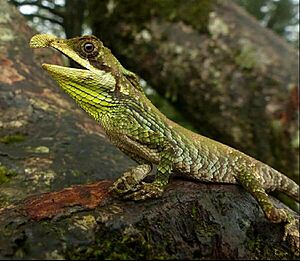Leaf-nosed lizard facts for kids
Quick facts for kids Leaf-nosed lizard |
|
|---|---|
 |
|
| Conservation status | |
| Scientific classification | |
| Genus: |
Ceratophora
|
| Species: |
tennentii
|
The Ceratophora tennentii, also known as the rhinoceros agama or horn-nosed lizard, is a special type of lizard. It belongs to the family called Agamidae. This lizard is found only in Sri Lanka, which means it is endemic to that country.
Contents
What's in a Name?
The first part of its scientific name, Ceratophora, means "horn bearer." This is because of the unique horn-like shape on its nose.
The second part, tennentii, was chosen to honor James Emerson Tennent. He was an Irish politician who worked in Ceylon (now Sri Lanka) a long time ago, from 1845 to 1850.
Appearance and Features
The rhinoceros agama has a very unique "leaf-like" shape on the end of its nose. This special nose makes it easy to recognize!
These lizards can grow to be over 8 inches (20 cm) long, including their tail. Male lizards often have more green colors on their bodies than females. However, they can change their color to a reddish-brown when they need to. Female lizards usually have a shorter nose "leaf" than the males.
This lizard is not very fast or agile. Instead of running away, it uses its amazing camouflage (blending in with its surroundings) to hide from animals that might want to eat it.
Its head is oval-shaped and longer than it is wide. The special nose part is soft and flat, like a leaf. It has a small, blunt scale at the very tip.
The back of the lizard can be reddish-brown or olive green. The larger scales on its sides are often greener. It has dark marks on its throat and the sides of its neck. Its tail has about 20 dark brown stripes. The underside of its body is a creamy white color.
Daily Life and Behavior
The rhinoceros agama is a diurnal animal. This means it is mostly active during the day. We still have a lot to learn about how this interesting lizard behaves in its natural home.
Where It Lives
You can find the rhinoceros agama in the wet, tropical cloud forests of the Knuckles mountains in Sri Lanka. It lives at high places, between 760–1,220 m (2,490–4,000 ft) above sea level. It has also been seen in a few other forest areas.
What It Eats
This lizard enjoys eating insects and other small creatures with many legs, like spiders. These small animals are called arthropods.
Reproduction and Life Cycle
The rhinoceros agama reproduces by laying eggs. This means it is a sexually reproducing animal, just like many other lizards.
Threats to Its Survival
The rhinoceros agama faces several dangers that threaten its existence. These include:
- deforestation: when forests are cut down.
- pesticides: chemicals used to kill insects, which can harm lizards too.
- climate change: changes in the Earth's weather patterns.
- forest fires: fires that destroy its home.
A lot of the lizard's forest home has been cleared away. This happened over the last 200 years for things like illegal logging (cutting down trees illegally) and to create farms for cardamom, coffee, tea, and rubber plants.
Protection Efforts
Since 2006, the rhinoceros agama has been a protected species because it is endangered. This means it is against the law to trade or sell these lizards.
In 2000, areas above 1,067 m (3,501 ft) in the mountains were made into protected conservation forests. This meant that growing cardamom plants had to stop in these areas. However, instead of the natural forest growing back, some areas were taken over by fast-growing weeds like mistflower (Eupatorium riparium) and lantana (Lantana camara). The IUCN (International Union for Conservation of Nature) officially put the rhinoceros agama on the endangered list in 2006.


